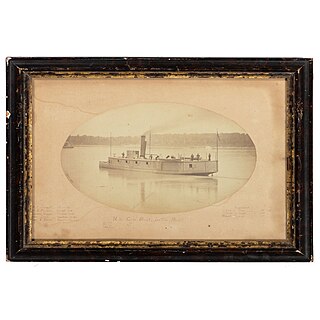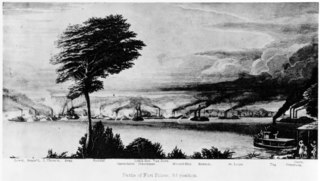The first USS Undine was a "tinclad" steamer in the United States Navy in 1864, during the American Civil War. She was captured on 30 October and put in service with the Confederates, but was not renamed before being burned, 5 days later, to prevent re-capture.

The third USS Water Witch was a wooden-hulled, sidewheel gunboat in the United States Navy during the American Civil War. She is best known as the ship fired on by Paraguay in 1855. In 1864 she was captured by the Confederate States Navy, and subsequently was taken into that Navy as CSS Water Witch.

Laurent Millaudon was a wooden side-wheel river steamboat launched at Cincinnati, Ohio, in 1856 operating in the New Orleans, Louisiana, area, and captained by W. S. Whann. At the beginning of the American Civil War she was taken into service by the Confederate Navy as CSS General Sterling Price. On 6 June 1862, she was sunk at the Battle of Memphis. She was raised and repaired by the Union army, and on 16 June 1862 was moved into Union service as USS General Price and served until the end of the war.

The United States Ram Fleet was a Union Army unit of steam powered ram ships during the American Civil War. The unit was independent of the Union Army and Navy and reported directly to the Secretary of War, Edwin M. Stanton. The ram fleet operated in coordination with the Mississippi River Squadron during the Union brown-water navy battle against the Confederate River Defense Fleet for control of the Mississippi River and its tributaries.

USS General Bragg was a heavy (1,043-ton) steamer captured by Union Navy forces during the American Civil War. She was outfitted as a U.S. Navy gunboat and was assigned to enforce the Union blockade of the waterways of the Confederate States of America.

USS Mound City was a City-class ironclad gunboat built for service on the Mississippi River and its tributaries in the American Civil War. Originally commissioned as part of the Union Army's Western Gunboat Flotilla, she remained in that service until October 1862. Then the flotilla was transferred to the Navy and she became part of the Mississippi River Squadron, where she remained until the end of the war.
USS Curlew was a Union Navy stern-wheel steamer that saw service during the American Civil War. Built in 1862 in Pennsylvania as a civilian vessel, she was purchased by the Union Navy on December 17, 1862. Converted into a tinclad gunboat, she saw service from 1863 to 1865, often serving on the Mississippi River, the Ohio River, and the Tennessee River. In May 1863, she was involved in a minor action against Confederate forces on the Mississippi River off of the shore of Arkansas. July saw Curlew take part in an expedition up the Red River of the South, the Tensas River, the Black River, and the Ouachita River that captured two steamers and destroyed two more and a sawmill. On May 24, 1864, she dueled with Pratt's Texas Battery while on the Mississippi River, and on November 4 of that same year, was near the action of the Battle of Johnsonville but was unable to join the fighting. Decommissioned on June 5, 1865, she was sold in mid-August and her further career is unknown.

USS Fern was a tugboat acquired by the Union Navy during the American Civil War. Her task was to tow other ships and barges, and to provide other duties that a tug could easily do, such as dispatch running.

USS Fort Hindman was a steamer acquired by the Union Navy during the American Civil War. She was placed in service and used by the Navy to patrol navigable waterways of the Confederacy to prevent the South from trading with other countries.
The first USS Thistle was a Union Army steamer acquired by the United States Navy during the American Civil War.

Little Rebel was a cotton-clad ram that had been converted from a Mississippi River steamer to serve as the flagship of the Confederate River Defense Fleet in the American Civil War. Sent from New Orleans to defend against the Federal descent of the Mississippi, she was among the force that engaged vessels of the Union Army's Western Gunboat Flotilla at the Battle of Plum Point Bend on May 10, 1862. On June 6, she again was involved in an action with the Federal gunboats, this time at the Battle of Memphis. In the battle, a shot from a Federal gun pierced her boiler, disabling her, and she was then pushed aground by the Federal ram USS Monarch and captured.

USS Rattler was a steamer acquired by the Union Navy during the American Civil War.

USS Cricket was a steamer acquired by the Union Navy during the American Civil War.
USS Juliet was a steamer acquired by the Union Navy during the American Civil War. She was used by the Union Navy as a gunboat in support of the Union Navy blockade of Confederate waterways.
USS Kenwood was a steamer acquired by the Union Navy during the American Civil War. She was used by the Union Navy as a gunboat in support of the Union Navy blockade of Confederate waterways.
USS Avenger was a large steamer with powerful guns acquired by the Union Navy during the American Civil War. She was used by the Union Navy as a gunboat in support of the Union Navy blockade of Confederate waterways. Because of her large size, she was also used, at times, as a cargo ship.
USS Gamage was a large steamer acquired by the Union Navy during the last months of the American Civil War. She was used as a gunboat to collect naval assets of the defeated Confederacy.
USS Grosbeak was a steamship acquired by the Union Navy during the American Civil War.
USS Huntress was a steamer acquired by the Union Navy during the American Civil War. She was placed into service as a gunboat assigned to support the Union Navy during the naval blockade of ports and rivers of the Confederate States of America.

USS Sumter was a 525-ton sidewheel paddle steamer captured by the Union Navy during the Union blockade of the American Civil War.












